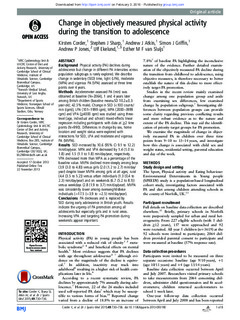| dc.contributor.author | Corder, Kirsten | |
| dc.contributor.author | Sharp, Stephen J. | |
| dc.contributor.author | Atkin, Andrew J. | |
| dc.contributor.author | Griffin, Simon J. | |
| dc.contributor.author | Jones, Andrew P. | |
| dc.contributor.author | Ekelund, Ulf | |
| dc.contributor.author | van Sluijs, Esther M. F. | |
| dc.date.accessioned | 2016-04-06T07:43:20Z | |
| dc.date.available | 2016-04-06T07:43:20Z | |
| dc.date.issued | 2013-11-22 | |
| dc.identifier.citation | British Journal of Sports Medicine. 2015, 49, 730-736 | nb_NO |
| dc.identifier.uri | http://hdl.handle.net/11250/2384119 | |
| dc.description | This is an Open Access article distributed in accordance with the terms of the Creative Commons Attribution (CC BY 3.0) license, which permits others to distribute, remix, adapt and build upon this work, for commercial use, provided the original work is properly cited. See: http://creativecommons.org/licenses/by/3.0/ | nb_NO |
| dc.description.abstract | Background: Physical activity (PA) declines during adolescence but change in different PA intensities across population subgroups is rarely explored. We describe change in sedentary (SED) time, light (LPA), moderate (MPA) and vigorous PA (VPA) assessed at three time points over 4 years.
Methods: Accelerometer-assessed PA (min) was obtained at baseline (N=2064), 1 and 4 years later among British children (baseline mean±SD 10.2±0.3-year-old; 42.5% male). Change in SED (<100 counts/min (cpm)), LPA (101–1999 cpm), MPA (2000–3999 cpm) and VPA (≥4000 cpm) was studied using three-level (age, individual and school) mixed-effects linear regression including participants with data at ≥2 time points (N=990). Differences in change by sex, home location and weight status were explored with interactions for SED, LPA and moderate and vigorous PA (MVPA).
Results: SED increased by 10.6 (95% CI 9.1 to 12.2) min/day/year. MPA and VPA decreased by 1.4 (1.0 to 1.8) and 1.5 (1.1 to 1.8) min/day/year, respectively. VPA decreased more than MPA as a percentage of the baseline value. MVPA declined more steeply among boys (3.9 (3.0 to 4.8)) versus girls (2.0 (1.2 to 2.7) min/day/year) despite lower MVPA among girls at all ages; rural (4.4 (3.5 to 5.2)) versus urban individuals (1.3 (0.4 to 2.3) min/day/year) and on weekends (6.7 (5.2 to 8.1)) versus weekdays (2.8 (1.9 to 3.7) min/day/year). MVPA was consistently lower among overweight/obese individuals (−17.5 (−3.9 to −2.5) min/day/year).
Conclusions: PA decreases and is replaced by SED during early adolescence in British youth. Results indicate the urgency of PA promotion among all adolescents but especially girls and in rural areas. Increasing VPA and targeting PA promotion during weekends appear important. | nb_NO |
| dc.language.iso | eng | nb_NO |
| dc.publisher | BMJ Publishing Group | nb_NO |
| dc.title | Change in objectively measured physical activity during the transition to adolescence. | nb_NO |
| dc.type | Journal article | nb_NO |
| dc.type | Peer reviewed | nb_NO |
| dc.subject.nsi | VDP::Social science: 200 | nb_NO |
| dc.subject.nsi | VDP::Social science: 200::Social science in sports: 330 | nb_NO |
| dc.subject.nsi | VDP::Social science: 200::Social science in sports: 330::Other subjects within physical education: 339 | nb_NO |
| dc.source.journal | British Journal of Sports Medicine | nb_NO |
| dc.identifier.doi | 10.1136/bjsports-2013-093190 | |
| dc.description.localcode | Seksjon for idrettsmedisinske fag / Department of Sports Medicine | nb_NO |
